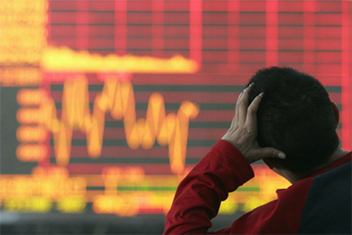Falling Dollar as Trump Trade Tumbles into Investor “Meh”
The U.S. dollar got hit hard again today as the Trump Trade continues to reverse and investor sentiment becomes more neutral – a big “Meh.”
The U.S. dollar is continuing its steep decline today as the AMEX U.S. Dollar Index makes new lows for 2017 and is nearing the lowest point over the past year, pushing down towards 94.
This represents not only an unwinding of the so-called Trump Trade, but speaks to how weak economic data has been coming in relative to expectations, (we’ve talked about this extensively which you can read about most recently here and here) AND relative to what we are seeing outside of the country. This decline has been driven primarily by the euro, the Mexican peso and the Japanese yen.
The dollar fell as the European Central Bank President, Mario Draghi, delivered a talk conveying more optimism for the European Union, citing growing political tailwinds, and the emergence of reflationary pressures. This came as Monday’s Durable Goods report showed the American economy is treading water, with Shipments and New Orders both dropping 0.2 percent month-over-month versus expectations for 0.4 percent gains. Core Capex has basically stagnated since February and despite all the euphoria in tech stocks, booking for new computers and electronics also declined 0.2 percent month-over-month and has now declined in 3 out of the past 4 months, which translates into a 6.5% decline on an annual basis: a long way from the 10 percent annual growth rate we saw at the start of 2017.
The Chicago Fed National Activity Index declined in May, the second decline in the past 3 months with the 3-month moving average essentially flatlining.
Looking over at France, with the recent win by Macron the economy there is looking much more upbeat as single-family housing permits rose 17 percent year-over-year versus 6 percent in the U.S. Single-family housing starts rose 19.4 percent in France and 8.5 percent in the U.S. In addition, mortgage purchase applications in the U.S. have fallen in 6 out of the past 7 weeks.
In Germany, the lfo business sentiment index recently hit a record high and across the Eurozone a collective sigh of relief can be heard as Italy is addressing its NPL (non-performing loan) problems. The latest was with a mix of state bailout, to the tune of €17b, on Banca Popolare di Vicenza and Veneto Banca that has equity and junior bondholders wiped out, protecting only senior note holders and depositors. More is likely to follow.
Looking at yesterday’s Consumer Confidence Survey, while the overall index rose from 117.9 to 118.9, it didn’t make up for the decline of 7.3 during April and May. That’s not terribly concerning, but this other bit in the details is. While the index for the Present Situation rose from 140.6 to 146.3 and is at the highest level since June 2001, Expectations fell again for the third consecutive month and are now at the lowest level since January. This type of divergence typically precedes a recession and if we look at these moves over the years, a recession typically hits 9 months after Expectations peak. That peak, so far, looks to have been in March.
Yes, but those Fed guys sound oh so confident despite tightening into an economy with slowing growth, declining inflation, weakening credit growth and a flattening yield curve.
- Since World War II, the Fed has engaged in 13 tightening cycles
- During 10 of those cycles, the economy slid into a recession
- In the 3 where a recession did not occur, GDP growth fell by 2 to 4 percent. With current GDP growth struggling to get above 2 percent, that’s worth noting.
Meanwhile, the equity market is mostly yawning.
The VIX has now dropped below 10 eight times in 2017. To put that into perspective, in the 22 years from 1994 through the end of 2016, the VIX saw that level all of 7 times!
In the past month, short position contracts on the VIX have doubled to now sit at a record level.
Over in the bond market, the view of the economy isn’t all that rosy. As of June 20th, the net longs on the 10-year Treasury hit a level we haven’t seen since December 2007.
Today’s AAII Investor Sentiment report showed that neutral sentiment is at its highest level since last August at 43.4 percent while bullish sentiment declined from 32.7 percent to 29.7 percent. This market is seriously astounding with a record 130 consecutive weeks where half the investors surveyed were not bullish, while we’ve had such a smooth melt up in the first half of 2017. Only one other year have we seen even less of a pullback during the first half! Meanwhile, the Bears are also scratching their heads with bearish sentiment falling from 28.9 percent to 26.9 percent, the lowest level since the first week of the year.
With economic data coming in well below expectations while the market has continued its melt up (today notwithstanding) despite bonds telling a worrisome tale with falling long-term rates and a flattening yield curve, it is no wonder investor sentiment is increasingly a neutral “meh..” or perhaps more of an “Eh…?”




